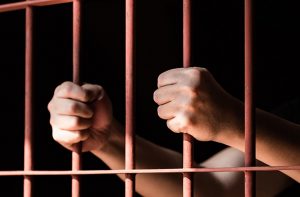What The Closing Of Rikers Means To The Criminal Justice Movement
Is the idea that smaller, neighborhood prisons engender better treatment a pipe dream or a practical step in the de-carceration movement that might serve as a blueprint?
 Rikers Island sits on a slip of land encircled by barbed wire, tucked beneath open sky where the sound of prison alarms are punctuated by seagull cries and the steady overhead drone of jets leaving LaGuardia. Looking out a cell window at the glistening water that separates Rikers from the mainland, an inmate is tantalized by freedom so close, yet impossible to attain.
Rikers Island sits on a slip of land encircled by barbed wire, tucked beneath open sky where the sound of prison alarms are punctuated by seagull cries and the steady overhead drone of jets leaving LaGuardia. Looking out a cell window at the glistening water that separates Rikers from the mainland, an inmate is tantalized by freedom so close, yet impossible to attain.
Even for visitors, lawyers, or family members, Rikers has long been a black hole of poor management and isolation. It takes the better part of a day to get there by public transportation, and once there, there’s no telling whether you’ll get in, or how long it will take to see the subject of your visit.
I’ve waited up to three hours only to be told at the end of a long morning that because of an alarm, “there’s no movement” in the building.

How Generative AI Will Improve Legal Service Delivery

The funny thing is, the island itself is not a bad place as long as you’re not stuck in one of its 10 giant jails. It’s surrounded by water. There’s a clean wind-swept smell. The attorney is taken to the facility where his client is housed on an old-timey yellow school bus steered by a correction officer blasting R & B. But that’s where the novelty stops. You’re then dropped at the prison gate and enter a soulless waiting room with barely a place to sit, either too cold or too hot, and a vending machine stocked with candy and chips for those unlucky enough not to have eaten before they came. Then the waiting starts.
New York officials have been talking about closing Rikers for years and last week voted to do just that. They set a deadline of 2026 and promised to build four smaller prisons in each borough. The stated motivation is to make it easier to get inmates to courts, for families to visit their loved ones, and also, hopefully, to provide better, cleaner, more humane facilities for inmates. (Skeptics feel it’s about grabbing the Rikers real estate for more profitable uses.)
But is the idea that smaller, neighborhood prisons engender better treatment a pipe dream or a practical step in the de-carceration movement that might serve as a blueprint for cities around the country?
There’s no doubt that Rikers is a dangerous place. I’ve had clients who’ve been stabbed, slashed, and beaten. I had one case where an inmate was locked in an eight-by-ten cell 23 hours a day without air conditioning during a July heat wave. He was punished for not obeying a “directive,” but had recently been stabbed so lay in his bed most of the time. Unbeknownst to him, a blood clot had developed in his leg that ran from his thigh to his shin. When he got up to leave segregation and return to general population, part of it broke off, migrated to his lungs, and killed him. My client was the guy who’d originally stabbed him. Instead of assault, my client was then charged with murder under the theory that he was the proximate cause of the man’s death.
Sponsored

Legal AI: 3 Steps Law Firms Should Take Now

Is The Future Of Law Distributed? Lessons From The Tech Adoption Curve

Early Adopters Of Legal AI Gaining Competitive Edge In Marketplace

Early Adopters Of Legal AI Gaining Competitive Edge In Marketplace
But creating smaller jails in neighborhoods doesn’t necessarily solve the problem. Yes, such jails should be easier to visit. There should be less red tape getting in and out of the facility and, theoretically, it should take less time to locate the inmate and escort him to the visit. All of this is good. There might be more control over how the smaller prisons are run and who’s in charge.
But unless and until there’s reform in how we define the primary goal of jails which are currently warehousing and punishment, inmates won’t be treated any better and won’t be released in a position where they’re likely to have a chance at not re-offending. Smaller does not necessarily mean safer or better.
There’s already a small prison in Brooklyn sandwiched between Schermerhorn and Atlantic Ave., adjacent to coffee shops, churches, and retail stores. But even there, I’ve had clients injured in fights, beaten by corrections officers, and one was even poisoned. They have no better education initiatives than Rikers, and in fact, because of the smaller size, have less space to hold such programs.
Moving the prisoners out of Rikers is only one small step toward criminal justice reform. What needs to happen is a new approach to thinking about incarceration as a time not only to house offenders, but actually help them. Inmates are literally a captive audience. What better opportunity to take classes than when you can’t do anything else?
If we really want people to come out a step up from when they went in, education and mental-health and drug-abuse counseling are the best approaches.
Sponsored

How Generative AI Will Improve Legal Service Delivery


Navigating Financial Success by Avoiding Common Pitfalls and Maximizing Firm Performance
Otherwise, it won’t matter if Rikers is closed or open. Putting guys in a pen with nothing to do but build their muscles, get frustrated, and pick fights only guarantees more trouble, no matter where they’re housed.
Toni Messina has tried over 100 cases and has been practicing criminal law and immigration since 1990. You can follow her on Twitter: @tonitamess.







